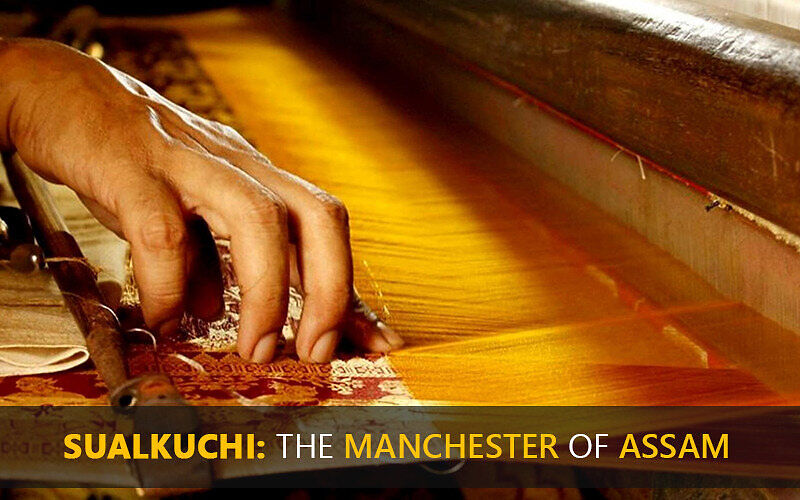
Sualkuchi: The Manchester of Assam
If you are thinking we are talking about football, you are wrong. Manchester is a city in England that has high GDP as well as home to two legendary football clubs. But what else makes Manchester famous? Apart from its sporting legacy Manchester is renowned as Europe's top cotton and textile producing city. Manchester is considered the world's first industrialized metropolis. So, now you might be wondering, how are Manchester and Sualkuchi of Assam related?
A small village in Assam, Sualkuchi, is where the entire population uses silk to weave magic. The village is known as the Manchester of Assam or the Manchester of East for its similarity in contribution to the textile industry. It is one of the largest weaving villages in the world that has been engaged in weaving exquisite silk fabrics. The village is particularly famous for Muga - the golden silk of Assam which is not produced anywhere in the world.
History
Originally, this village was a crafts community with thriving cottage industries including hand weaving, pottery, gold production, and oil processing. The others eventually fell behind in adapting to the times, while handloom weaving kept prospering economically.
According to historians, the tradition of silk weaving started in Sualkuchi in the 11th century when king Dharma Pal of the Pala dynasty supported the trade by bringing 26 weaving families from Tantikuchi in Barpeta to Sualkuchi.
However, it was under the reign of Ahom that this industry and this hamlet had their most glorious growth. After conquering the Mughals in the middle of the 17th century, Sualkuchi began to take shape as the silk weaving village, established by MomaiTamuliBarbarua under the regime of Ahom King SwargadeoPratapSingha. Additionally, it is said that the items were a sign of luxury in the period and could only be purchased by noble and royal families.
Assam Silk
Although Assam is well recognized for its tea, it is also highly known for its silk manufacturing, particularly the Muga Silk that is exclusive to this area. Muga, Eri, and Pat are the three classic Assam Silk patterns. The non-mulberry silk category includes Muga and Eri silk, while the mulberry silk group includes pat silk.
Muga Silk
Muga Silk is recognized for its golden shine and gloss, which fascinatingly rises after each wash. Muga Silk is woven from the silk obtained from "AntheraeaAssamensis," or the Assamese native silkworm. The MugaMekhalaSador, the traditional clothing of Assamese women, is valued equally to the gold jewellery in a wedding trousseau, making Muga silk one of the most valuable silks.
Eri Silk
It is locally referred to as Ahimsa Silk and is produced without harming the silkworms in any way. This silk has a woolly texture since it is only produced lately after the Ailanthus silk moth emerged from its cocoon. The key characteristics of Eri Silk are its exceptional durability, moisture absorption, strength, and thermal properties, which make it ideal for use in both winters and summers. Nowadays this variant is becoming more popular because it is a sustainable and environmentally beneficial choice.
Pat Silk
It is also known as mulberry silk because the silkworm's larvae only consume mulberry leaves while they are in their cocoons. The production of Pat Silk is restricted in comparison to the other two varieties due to the small number of mulberry worms cultivated in Assam, despite being known for its distinctive off-white hues, high-quality fabric, long-lasting gloss, and durability.
Process in Making
The process of making silk is quite fascinating. Today, Sualkuchi is home to a number of narrow lanes, each of which is filled with the sweet rhythmic sounds of looms and flying shuttles. Every home has a loom, and you may witness weavers working on the Assamese traditional clothing known as mekhelasadors by hand.
The artisan begins by sketching out the desired designs on graph paper. Typically, the themes are drawn from the flora and fauna of Assam; flowers, peacocks, rhinos, deer, and other animals. The "Jaapi" is a further prevalent design (traditional Assamese hat). The weaver begins creating punched cards as soon as the pattern is complete. Punching holes along the lines of the pattern onto rectangular cardboard pieces create a punch card. The weaver will spend the following six days creating one sador, possibly longer if the pattern is more complex. Historically, golden zari was used to make motifs; today, silk and cotton threads are used instead.
Significance of Sualkuchi in the textile industry
Sualkuchi is the textile centre of Assam. The quality of the Muga and Pat silks, as well as the Eri silk and Endi cloth from this area, is well known. These locally produced materials are in high demand throughout Assam and other regions of India for Mekhela chadors and Gamosas.
One of the first industries to grow in India was the textile and clothing industry.
India is thought to be in the first place when it comes to the number of installed weaving looms, accounting for 64% of all looms installed worldwide! In Sualkuchi, the silk industry directly or indirectly employs more than 25,000 people. More than 31 lakh linear meters of silk fabrics worth roughly Rs. 9,000 lakhs are produced by Sualkuchi alone.
The semi-automatic Fly shuttle handloom manufacturing system has now been implemented throughout the entire Sualkuchi, and 73.78% of the town's households are currently involved in hand-loom commercial weaving. According to the 2002 Census of Hand-loom, there are 13752 operational commercial hand looms in Sualkuchi. Of these, 54.75% are operated by women weavers who are essentially hired from outside Sualkuchi.
To support Assam's textile businesses, the then-chief minister of Assam opened a textile park on the outskirts of Guwahati. For the improvement of the industry, numerous government pprogramsand initiatives have been implemented in the past ,and more recently.
Conclusion
Nowadays, some weavers import less expensive yarns from areas like Mysore and Bhagalpur due to the escalating costs of these local silks. The Covid pandemic has had a significant impact on people all throughout the world, but for weavers, it goes beyond a simple health issue. It is more of a threat to their livelihood and in return is a catastrophe for society and culture.
The handloom sector makes up 90% of India's unorganized economy, so the future if not planned properly may be filled with uncertainties. In addition to suffering significant losses, weavers are also heavily in debt as a lack of raw materials has meant that they have to procure linens from outside at higher rates.
Protests by Assamese weavers against the sale of synthetic silk or Benarasi silk with Assamese themes under the label of Sualkuchi silk have become another pressing issue. Due to rising commercialization, this has become very prevalent where many clothing stores sell cheaper and replica silk mekhela chadors.
It is time Govt. introduces regulatory bodies to safeguard indigenous industries across the states from commercial sharks whose motives are just limited to money minting. There has to be systematic planning and support for our local artisans - which will ensure Sualkuchi stays relevant for years and generations to come.
Disclaimer: The opinions expressed in this article are those of the author's. They do not purport to reflect the opinions or views of The Critical Script or its editor.

Newsletter!!!
Subscribe to our weekly Newsletter and stay tuned.
















Related Comments